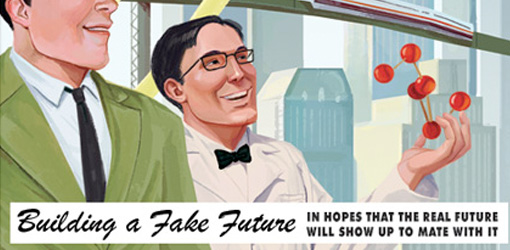A Futurable Now
Posted on December 19, 2010 | posted by:
Futurism Poster conceived by David Malki and designed and painted by the talented Carly Monardo. http://www.topatoco.com/merchant.mvc?Screen=PROD&Store_Code=TO&Product_Code=WON-FUTURISM&Category_Code=WON#pic
A futurable now is a condition of continued improvement that is both adaptable and flexible, maintaining a state of collective engagement to actively create and support an intentional future. We need to engage with our communities to incite and nurture a sense of exploration and wonder. By doing this we will spark our inherent curiosity, growing a climate of thought that can lead to revealing possibility – guideposts for our future.
By encouraging poetic experiences and moments of whimsy we can become further in touch with what makes us human and the qualities to define a desired future. To fulfill our potential we will need experienced visionaries and new enthusiasts. We will need a clear plan for infusing a value of futurability to our youngest generations through intentional experiences developed through play, entertainment, education and activism. We need to create tools for understanding that seed ideas to build momentum and shift our everyday considerations – that will spark the question ‘Does this support a futurable now?’ propelling us and future generations into a future of improved well-being.
It is not enough to solve the problems of today; band-aids, though well intended, combine in unexpected ways to create undesirable future states. What we require is future building, behavioural change for both individuals and organizations that support ownership in our collective future and enable and encourage the ability to act. To do this we must create meaningful connections, an empowered network that encourages each connector (participant) to engage in building and supporting a future vision of improved well-being. This collective vision must be transparent, flexible and iterative – continually responsive to changing conditions and critical reflection.
To tackle the wicked problems of tomorrow we need a network of ‘creative villages’, agile teams that work not in parallel but in harmony with a shared future view as their driver. This can create an open source playground for experimentation and iteration through prototyping on local scales which then can be adopted in other localities and potentially amplified to meet the needs of larger communities. This testbed can reveal the possibilities of tomorrow while creating an improved ‘now’. These networks may be ad hoc neighbor groups, community leadership councils, and established nonprofits. They can create influence from a small community level, such as a grade school play, to building ideas and action plans in world wide concept ‘jams’. It is the open source nature of transparency and shared motivation that will give these various nodes cohesion and purpose.
We need to make the future a compelling topic with direct avenues for action. We need triggers for change, both high profile interventions, like Al Gore’s ‘An Inconvenient Truth’ (He won a Nobel Peace Prize – this isn’t easy work), and grassroots successes. A sense of urgency is required to propel well-meaning philosophies into action. We need to create the environment for emergent actions and new behaviours, to gain momentum and evolve. Critical reflection needs to become a part of the everyday to maintain ownership in our future.
By defining a structure of value and of success measures we will be able to foster a culture of imagination, pleasure, responsibility, and accountability. We can encourage everyday thoughtfulness that will demand quality over quantity and remind us of the importance of community, poetics, whimsy, and play. By looking to the future we will discover a ‘now’ that is full of pleasures once ignored and forgotten, and a future we can be proud of.
Design Activism by Alastair Fuad-Luke
Design Futuring by Tony Fry
Massive Change by Bruce Mau